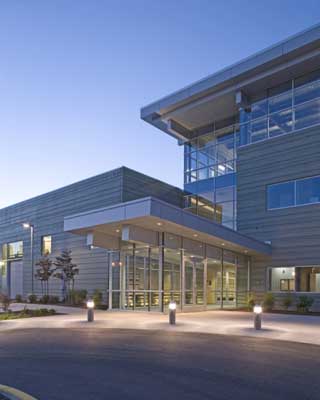
Grand Award Winner
Non-Industrial Tilt-up

Berlex Project Atlas
Location: Lynnwood
Owner/developer: Berlex Laboratories
Project team: Lease Crutcher Lewis, general contractor; The Conco Companies, concrete contractor; Skanska USA Building, construction manager; IDC Architects, architect; CH2M Hill, structural engineer; Rinker Materials, ready-mix supplier
Berlex Laboratories sought a clean design with a Northwest style for its new manufacturing facility. To achieve that goal, the biopharmaceutical company’s 98,000-square-foot building was made from a combination of tilt-up and cast-in-place concrete colored in an earthy olive shade. Using the two types of construction allowed for economy and flexibility.
Long horizontal reveals were made to create crisp edges and fine shadow lines. Flat glass and aluminum panels completed the palette.
Grooved concrete walls turn inside, becoming the north wall of the two-story lobby and blurring the line between indoors and out. At night, lights set into the floor illuminate the grooves in the wall.
The project has space for offices, laboratories, utilities, warehousing and clean manufacturing. The utilities were nestled into the site’s hillside to help reduce the project’s impact on the adjacent residential neighborhood.
Massive concrete retaining walls allow two of the building’s three stories to daylight at grade level.
Because of the sloping site and varying programmatic requirements, few of the tilt-up panels are identical in height, width or openings. A construction challenge occurred while Lease Crutcher Lewis stack-cast the panels because it was not able to cast all panels side by side to visually check groove alignment. The contractor used measuring tape and chalk lines to align the beveled reveals around corners and down the hillside. Another contractor, Conco Companies, poured cast-in-place walls adjacent to the tilt-up walls to continue the reveals and make the seam between construction types invisible.
Because of the finish quality, a semi-transparent stain was used instead of a thick textured paint designed to hide mistakes.
The finishing touch was a series of concrete panels embedded into the walls with the hand prints of all the project participants.